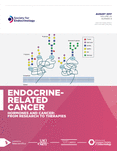Copy number variations of E2F1: a new genetic risk factor for testicular cancer
- Maria Santa Rocca1,
- Andrea Di Nisio1,
- Arianna Marchiori1,
- Marco Ghezzi1,
- Giuseppe Opocher1,2,
- Carlo Foresta1 and
- Alberto Ferlin1⇑
- 1Department of Medicine, DIMED University of Padua, Padua, Italy
- 2Familial Tumor Unit, Veneto Institute of Oncology IOV-IRCCS, Padua, Italy
- Correspondence should be addressed to A Ferlin; Email: alberto.ferlin{at}unipd.it
Abstract
Testicular germ cell tumor (TGCT) is one of the most heritable forms of cancer. In last years, many evidence suggested that constitutional genetic factors, mainly single nucleotide polymorphisms, can increase its risk. However, the possible contribution of copy number variations (CNVs) in TGCT susceptibility has not been substantially addressed. Indeed, an increasing number of studies have focused on the effect of CNVs on gene expression and on the role of these structural genetic variations as risk factors for different forms of cancer. E2F1 is a transcription factor that plays an important role in regulating cell growth, differentiation, apoptosis and response to DNA damage. Therefore, deficiency or overexpression of this protein might significantly influence fundamental biological processes involved in cancer development and progression, including TGCT. We analyzed E2F1 CNVs in 261 cases with TGCT and 165 controls. We found no CNVs in controls, but 17/261 (6.5%) cases showed duplications in E2F1. Blot analysis demonstrated higher E2F1 expression in testicular samples of TGCT cases with three copies of the gene. Furthermore, we observed higher phosphorylation of Akt and mTOR in samples with E2F1 duplication. Interestingly, normal, non-tumoral testicular tissue in patient with E2F1 duplication showed lower expression of E2F1 and lower AKT/mTOR phosphorylation with respect to adjacent tumor tissue. Furthermore, increased expression of E2F1 obtained in vitro in NTERA-2 testicular cell line induced increased AKT/mTOR phosphorylation. This study suggests for the first time an involvement of E2F1 CNVs in TGCT susceptibility and supports previous preliminary data on the importance of AKT/mTOR signaling pathway in this cancer.
- Received 22 December 2016
- Accepted 18 January 2017
- Made available online as an Accepted Preprint 19 January 2017
- © 2017 Society for Endocrinology












